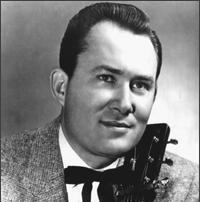
Cliff Carlisle
by Jason Ankeny\r White country bluesman Cliff Carlisle was among the most prolific recording artists of the 1930s; a blue yodeler in the tradition of Jimmie Rodgers, he helped pioneer the popularity of the Hawaiian steel guitar in country music, while the ribald imagery of his material established him among the wittiest and most reckless composers of his day. Born in Taylorsville, KY, on May 6, 1904, as a child Carlisle was enamored of the Hawaiian guitar recordings of Frank Ferera, and eventually placed a steel nut under the strings of his own guitar to achieve a similar sound. Rural blues was also an early influence, and while working on his familys farm he also absorbed the inspiration of old-timey string bands and sacred songs; he began his performing career at the age of 16, performing socials and local talent contests alongside a cousin, Lillian Truax. After Truaxs marriage disbanded the duo, in 1924 Carlisle began collaborating with Wilber Ball, a construction worker who also played guitar and sang tenor harmony; over the course of the decade to follow, the duo regularly toured the vaudeville and tent show circuit, performing across the country as quite possibly the first blue yodeling duet team. \r \r In 1930, Carlisle and Ball debuted on Louisville radio WHAS, a fledgling station their popularity helped establish; that same year Carlisle made his first recordings on the Gennett and Champion labels, virtually all of them firmly in the tradition of Jimmie Rodgers. In 1931, he and Ball actually recorded with the Singing Brakeman himself; that same year Carlisle also cut Shanghai Rooster Yodel, the first in a series of ribald barnyard-themed outings that served him throughout his career, and might have influenced similar tracks by Charley Patton (Banty Rooster Blues) and Howlin Wolf (Little Red Rooster). Upon signing to ARC in late 1931, Carlisles career truly took flight, as he landed a regular spot on Charlotte, NC, station WBT, followed by subsequent gigs at Chicagos WLS and Cincinnatis WLW. His younger brother, Bill, replaced Ball as rhythm guitarist circa 1934, and when Carlisle resumed recording in 1936 after a lengthy hiatus, his material became even saltier — Get Her By the Tail on a Down Hill Drag was a classic barroom boast, while That Nasty Swing employed metaphorical imagery of surprising explicitness. (He typically recorded his more blue material under a variety of pseudonyms, including Bob Clifford and Amos Greene.)\r \r During the mid-30s, Carlisles son — billed as Sonny Boy Tommy — began regularly appearing on live dates and recording sessions, a situation that often ran afoul of individual states child labor laws. The recordings Carlisle made with his son were typically mild and innocuous, but his solo sides continued to get down and dirty — A Wild Cat Woman and a Tom Cat Man offered a cartoonish portrait of domestic disputes, while the snarky Youll Miss Me When Im Gone was later covered by Elvis Presley as Just Because. In 1939, he recorded Footprints in the Snow, later to become a bluegrass standard; the song offered clear proof that consumers appetite for blue yodels was on the wane; in the years to follow, Carlisle was a regular on WMPS in Memphis, but by the early 50s he was essentially retired from the music industry, having recorded well over 300 sides during his heyday. He was rediscovered a decade later when the Rooftop Singers covered his Tom Cat Blues, leading to a handful of reunion performances with Wilber Ball and even the recording of new material for the Rem label. Cliff Carlisle died in Lexington, KY, on April 2, 1983; he was 78.\r
